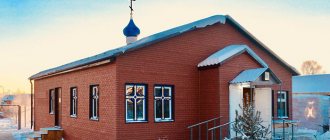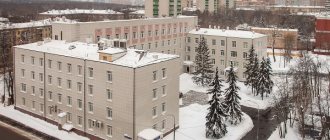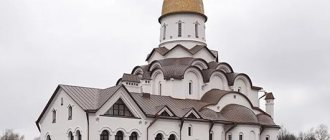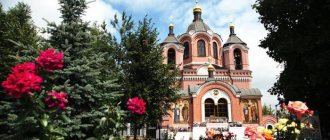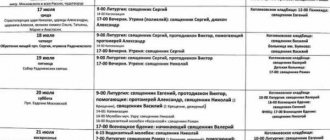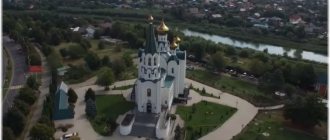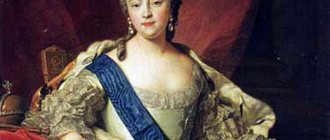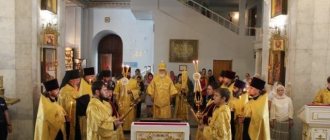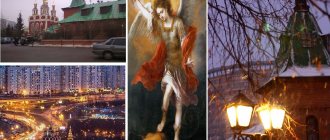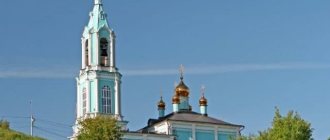The hill above Georgievsky Prospekt, not far from the village of Kamenka, was identified as the site for the construction of an Orthodox church when designing the new 17th microdistrict of the city of Zelenograd.
The project, which passed public hearings in January 2015, provided for the construction of a church with a clergy house, which was planned to house a refectory, a Sunday school for children, administrative and household premises.
The location of the temple is illuminated by history. There was a defensive line here during the Great Patriotic War. The foundation stone of the temple took place in honor of the Holy Great Martyr George the Victorious.
Church of St. George the Victorious in Zelenograd today
The main task of the temple is to become a church within walking distance for residents of the 17th microdistrict. The project of the temple complex was finally agreed upon in August 2022. The basis for the construction was the “Program 200”, which envisages the construction of 200 churches in Moscow.
Church of St. George the Victorious in Zelenograd
The buildings are erected with donations from individuals and organizations. The role of the Moscow government is to provide free plots for construction and lay communications. Therefore, the speed of construction directly depends on fundraising.
The Church of St. George the Victorious in Zelenograd is named after the holy great martyr, most revered in the Christian world. Saint George was extremely popular during early Christianity. It is believed that he patronized warriors, farmers, and cattle breeders.
At the moment, on the site of the temple complex for 700 believers there is a temporary one-story church. The prefabricated structure was previously located in Strogino and was the beginning of the Church of the New Martyrs and Confessors of Russia.
Today, on the territory of the Patriarchal Metochion of the Holy Great Martyr George the Victorious, in addition to the temporary church building, there are several cabins and a small Sunday school building. There is also a small flower garden here.
The church was erected in a new location in the summer of 2022, and the first liturgy was served in the church on August 27, 2022 by the dean of the Zelenograd district, Archpriest Konstantin Mikhailov.
The main decoration of the temporary temple is the ringing of the bells of its small belfry. Percussion instruments were donated to the temple by the Orthodox youth association “Bell”. There is an icon shop at the temple. Here you can buy candles, both simple and souvenir, and small icons.
Architect, exterior decoration, architectural ensemble
According to the architects' design, the temple is supposed to be built in the aesthetics of the Russian North. They decided to borrow the design of future pitched galvanized gable roofs from ancient Russian church architecture. The motifs of churches in the Arkhangelsk, Vologda, Pskov, and Novgorod regions were also taken as a basis.
The building of the future permanent temple is planned to be built in the likeness of the Church of the Holy Righteous John of Kronstadt, erected in the north-west of Moscow, in the Golovinsky district.
The draft version of the Church of St. George the Victorious in Zelenograd was commissioned from the Union of Architects of Russia. The project was developed by a group of designers from a creative workshop under the direction of the famous church architect Alexei Anatolyevich Mamonov.
Sketch of the future Church of St. George the Victorious in Zelenograd
According to the project of A. A. Mamonov, it is planned to build the main building of the church, next to which the parish house will be located. The belfry will connect the church and the parish house into a single whole, under which there will be an arched gate for the religious procession around the church.
According to the architect's plan, the main part of the interior space will be allocated to an extensive refectory. The eastern part of the interior is given over to the most important part of the church - the altar. In the side aisles there are planned premises for the altar and sacristy.
The project includes a baptismal church and a parish block. They will be located in the basement of the future church. It is planned to open Sunday school classes in the utility rooms, and there will also be a hall for general meetings and various holidays for children and their parents. There are also rooms in this part of the church for the parish office.
Church of St. blg. led book Alexander Nevsky in Alexandrovka
Story
A new temple in honor of the Holy Blessed Grand Duke Alexander Nevsky in the area of the former village of Aleksandrovka, in the 14th microdistrict of Zelenograd, is being built on the site of bloody battles in the December days of the Battle of Moscow 1941.
During those war years, on the site where the church in honor of St. Philaret, Metropolitan of Moscow is now located in the city of Zelenograd, there was the village of “Red October”. In December 1941, there was a Nazi stronghold here, which covered the village of Aleksandrovka. Enemy reinforcements approached from Alabushevo to Kryukovo through it. Only after the liberation of Alexandrovka did the liberation of Kryukovo become possible. She was the “key” of enemy defense. On December 7, the 1199th Regiment of the 354th Division attacked Red October. Fierce fighting continued for several hours until the enemy retreated under pressure from our troops. Pursuing the Nazis, our units occupied Aleksandrovka. The enemy defenses began to crumble.
During the liberation of Alexandrovka, soldiers of the 354th division died. Many of them were buried in a mass grave not far from the temple under construction. A memorial service is held at the burial site every year on the day the war began. The liberation of this settlement became a key moment in the successful development of the counter-offensive of our troops, which ended in the defeat of the German invaders. But the temple name in honor of the holy noble prince Alexander is not a simple consonance with the village of the same name. The date of the beginning of the defeat of the Nazi troops near Moscow is called both December 6 and December 7. On December 6, the Orthodox people celebrate the memory of the defender of the Russian land, the holy blessed Grand Duke Alexander Nevsky.
After the memorable military parade on November 7, 1941, his name was on the lips and ears of our soldiers. The beginning of the counter-offensive near Moscow is associated with the name of the holy prince; victory in this battle was won in his name. The results of the Moscow battle were inspiring. The spiritual and moral changes that took place in society were significant. Military posters were printed, political classes were held, commanders and political workers were called upon to imitate the deeds of the “great ancestors.” Therefore, it is December 6 that is so important to consider as the date of the beginning of the defeat of German troops in this battle.
By the way, the coming Easter on April 5, 1942, on which the state of siege in Moscow was lifted and night movement was allowed, coincided with the 700th anniversary of the defeat of the German knights in the Battle of the Ice by the holy Prince Alexander Nevsky.
Chronicle of the construction of the temple 2011 Autumn, the beginning of construction of the temple 2012 May 6 - the first prayer service June 14 - consecration of the foundation stone (the day of remembrance of the holy righteous John of Kronstadt) October 13 - the beginning of the Sunday school in the district library 2013 Spring, the beginning of the construction of the clergy house August 21 - installation domes on the temple August 25 - consecration and installation of the cross on the dome of the temple 2014 January 2 - the first Divine Liturgy in the camp church (the day of remembrance of the holy righteous John of Kronstadt) December 14 - the first Divine Liturgy in the house church 2015 October 11 - the beginning of the Sunday school school year in house clergy 2016 October 1 - certification of the Sunday school 2017 January 2 - first Divine Liturgy in the church (the day of remembrance of the holy righteous John of Kronstadt) April 2 - first divine service by the bishop's rank 2018 October 14 - the territory of the complex was paved December 2 - a marble iconostasis was installed
History of construction
Construction of the main building is at the ground floor stage. The foundation stone of the temple complex was consecrated on December 19, 2020 by the vicar of His Holiness the Patriarch, Bishop Paramon of Naro-Fominsk.
The temple, the clergy house and the entire church territory will occupy an area of 0.5 hectares. The estimated length of the future structure will be 26 m, and the height will be 17.7 m. The temporary church, which has already been erected on the territory of the Church of St. George the Pobendonosets in Zelenograd, is made of laminated veneer lumber.
The load-bearing structures will also be built from timber, and in the future the assembled frame will be covered with brick. The main wooden structure was ordered immediately for the domes, which will significantly reduce construction time. The temple can be assembled in a few days.
In existing parishes in Zelenograd, charitable donations were announced for the construction of a new church. In total, it is necessary to collect 4-5 million rubles. Volunteers from among Orthodox youth joined in fundraising. They not only collected voluntary contributions, but also participated in cleaning the territory and preparing it for the construction of the church.
Where is the church
The official address of the Alexander Nevsky Church is the village of Knyazhye Lake, Nevskaya Street, no. 768.
You can reach it by public transport:
- from the Nakhabino railway station - by buses No. 20, 21 and 173k to the stop "Princely Lake Village";
- from the metro station "Shchukinskaya" or "Strogino" - minibus No. 480 to the stop "Monument to the Defenders of Moscow".
The village is located on the 24th kilometer of the Novorizhskoe highway, so you need to drive by car from Pavlovskaya Sloboda in the direction of Zvenigorod, following the signs.
Temple (church) of Alexander Nevsky on the map of the village of Knyazhye Ozero
Interior decoration
The snow-white church complex is the future of the Church of St. George the Victorious. At the moment, its interior decoration and appearance are of no interest to pilgrims, because it is very modest. There are no relics or particularly revered shrines here.
There is a large cross in the prayer hall, and icons transferred from other parishes and donated by parishioners are hung on the walls. An iconostasis is visible on the walls; burning lamps hang in front of the icons.
Shrines and relics of the temple
The Church of St. George the Victorious in Zelenograd gratefully accepts gifts from local residents. Zelenograd residents donate icons to the future holy place.
The temple was decorated with holy relics donated by parishioners:
- Shroud of the Savior and Mother of God.
- Icon of St. Sergius of Radonezh.
- Icon of St. Nicholas of Myra.
- Icon of the Mother of God “Three Joys”.
- Icons of the Twelfth Feasts.
- Iconostasis row of saints in the icon case.
Architecture Features
A quick glance at the temple complex gives the impression that it was built in the 19th century, but a more sophisticated person can easily determine that these are modern buildings. The snow-white church with a tented bell tower in the Russian style, all 9 chapters topped with crosses, soars up more than 60 m.
Russian (late pseudo-Russian, Russian-Byzantine) style appeared in domestic temple architecture at the turn of the 19th-20th centuries. on the rise of interest in national traditions. This is a kind of eclectic direction, combining Byzantine, ancient Russian and folk traditions with more modern ones - romanticism, modernism and other movements.
The church has eight dedicated chapels, consecrated in honor of:
- apostles Peter and Paul;
- John the Baptist;
- Holy Myrrh-Bearing Women;
- St. Sergius of Radonezh;
- Tikhvin and Korsun icons of the Mother of God;
- All saints.
The main one is dedicated to the heavenly patron - the blessed Prince Alexander Nevsky.
The author of the project was the famous Moscow architect Sergei Borisov, who was invited by decision of the council of the parish community of the Alexander Nevsky Church on Prince Lake.
Before approval, the development was discussed at the XXIII International Congress of Architects, which was held in the Italian city of Turin. In addition, it was approved at the Christmas Readings.
| Member of the Union of Moscow Architects Sergei Vladimirovich Borisov (born 1970) graduated from the Moscow Architectural Institute - State Academy of MArhiI in 1994 and worked in design bureaus for about 20 years. In 2012 he defended his thesis on the topic: “Space-planning principles for the design of Orthodox churches in the Moscow region.” Since 2014 he has been teaching at the academy. Author of more than 100 scientific articles and publications on the topic of temple building, as well as 5 major implemented projects. According to his drawings, churches and chapels were built in the Pskov, Tomsk, Vladimir, Moscow regions and in Ukraine. |
Experts note the excellent acoustics of this church - under its high arches, sounds flutter and reflect from the dome and walls, creating overlaps and echoes. The echo gives the sound a special flavor, forming a special sound space, as if separating those praying from the outside world.
Interior decoration
The central temple and the chapels of the lower temple are united by a wooden gilded iconostasis, which was made by carvers from Izograph. Stylistically, he supports the pseudo-Russian style.
Another one, a five-tiered baroque iconostasis almost 20 m high, separates the altar of the central church from its middle part. It was created on the model of the iconostasis of the Smolensk Cathedral of the Assumption of the Blessed Virgin Mary. Work on its design began in 2010, and to date has not yet been completed.
The icons located in both iconostases are painted in the so-called academic manner.
Academic icons appeared in Russia in the mid-18th century. In contrast to the conventional “Byzantine” style, these holy images are close to realistic images. The name “academic” was assigned to them because they began to be painted by graduates of the St. Petersburg Academy of Arts: Vasily Vasnetsov, Karl Bryullov, Nikolai Bruni, Vasily Vereshchagin, Mikhail Vrubel, and then other talented painters.
The polished stone floors deserve special attention. The multi-colored marble mosaic, which took about a year to create, is striking in its magnificence. The inlaid panels around the columns, on which craftsmen invited from Italy worked, required especially a lot of work.
Clergy, mentors
The rector of the Patriarchal Metochion, Hieromonk Mikhail Ilyin, born in 1969, also heads the parish of the Church of the Holy Blessed Prince Peter and Princess Fevronia in Stary Kryukov (the home church of the Zelenograd comprehensive Orthodox school "Zvonnitsa").
Previously, he headed the “Bell” Orthodox youth association, which operates at the Church of St. Nicholas of Myra.
Father Mikhail loves and knows how to work with young people. The rector devotes a lot of time to pastoral care at the nearby hospice “Zelenograd” (a branch of the State Budgetary Healthcare Institution “Center for Palliative Care of the Department of Healthcare”). It has become a tradition for the rector to perform the Great Blessing of Water in the hospice.
“Memory Watch” in the village of Kamenka
Every year, on June 22, a “Memory Watch” is held at a mass grave in the village of Kamenka, and parishioners also participate in it. Rector Mikhail Ilyin performs a funeral litany for the leaders and warriors killed on the battlefield, for those who died from wounds, disease and hunger, for those who died in captivity and hard work during the war.
Father Mikhail uses his passion for the history of his native land to unite the parish. Parishioners of different ages take part in organized conversations and excursions around Moscow and the surrounding area of the Patriarchal Metochion.
General view of the village of Knyazhye Lake
Knyazhye Ozero, a village conceived in the late 1990s, appeared on the map of the Moscow region in 2010, but construction work began here much earlier. Already on December 17, 2002, on the initiative of the construction company and future residents, the community of the future temple was registered, whose heavenly patron was the holy Prince Alexander Nevsky.
The place for the construction of the church was not chosen by chance - according to eyewitnesses, it was here on December 3, 1941 that the soldiers of the rifle division under the command of General Pronin stopped the advance of the German troops.
Another 3 days later, on December 6, the day when the Russian Orthodox Church honors the memory of the blessed Prince Alexander, the victorious offensive of the Red Army began from here. And 4 decades later, they perpetuated the memory of those events by erecting a memorial cross. The foundation stone of the church took place on October 12, 2005, and exactly a year later construction work began.
The dome elements of the temple building were erected using a special technology - “shotcrete”. Under the influence of compressed air, a concrete mixture of a special recipe was supplied through hoses to a height of 54 m and applied to the surfaces of nine reinforced concrete structures with a diameter of 3 to 7 m. This method made it possible to create a durable structure of increased strength, resistant to changes in temperature and humidity.
Just 4 years later, on April 11, 2009, Schema-Archimandrite Eli (Nozdrin) performed the minor consecration of the church, after which it became possible to lead regular liturgical life.
| Schema-Archimandrite Iliy (baptized Alexey Nozdrin) was born in 1932 in the Oryol region. He graduated from a mechanical engineering college, then studied at the Saratov and Leningrad Theological Seminary and Academy, and served in the Leningrad diocese. At the age of 34, he was tonsured a monk, after which he lived for ten years in the Pskov-Pechersky Monastery, and then for thirteen years on Mount Athos, being the confessor of the monastery of St. Panteleimon. In 1989 he returned to Russia and accepted the great schema with the name Elijah. Since that time he has been the confessor of Optina Pustyn, and a member of the Inter-Council Presence of the Russian Orthodox Church. |
A month later, in the lower chapel, consecrated in honor of the Holy Myrrh-Bearing Women, the first Divine Liturgy was celebrated. The guests present at this event presented the parish with icons of the Holy New Martyrs and Confessors of the Istra Land and St. Nicholas of Myra.
2009 turned out to be rich in significant events - by the fall the main construction work was completed and on September 15, 9 gilded domes with crosses were installed, the height of the largest of which is more than 5 m. This exciting event remained in the memory of parishioners and residents of the village for a long time, many of them who were watched for their consecration and rise.
Craftsmen from many Russian cities took part in the construction of the temple. Thus, the chapters with crosses were created by engineering employees from Volgodonsk, and they were covered with gold by specialists from the Izograf workshop located in Sergiev Posad. They are made in 2 colors – gold and brown. This emphasizes that the church is dedicated not to one saint, but to several at once.
In December of the same year, the miraculous icon of the Mother of God Hodehydria of Korsun was transferred from the State Russian Museum. This shrine attracts many pilgrims, one of whom was His Holiness Patriarch Kirill of Moscow and All Rus', who visited here on June 6, 2010.
The main construction work was completed by 2010 - on January 11, a cathedral service of the clergy of the Istra deanery took place in the main chapel, in which thirty clergy and more than five hundred laity took part. The first service in the upper church took place on Easter 2013. Later, the temple area was landscaped and surrounded by a brick fence.
For more than 10 years, the Alexander Nevsky Temple on Prince Lake has attracted not only residents of the surrounding village, but also the entire Moscow region and the capital, who come here to touch the numerous shrines carefully preserved in the church.
Social work, everyday life
All social work is carried out under the supervision of a social work coordinator. Church work is the responsibility of the confessors of the church. Free volunteers help them with this. Members of the church's board of trustees provide great assistance in social work.
The social service at the Church of St. George the Victorious was expressed gratitude for their participation and fruitful cooperation in the Children's Recreation Program “Moscow Shift - 2019”. The rector of the temple, Priest Mikhail Ilyin, was especially noted.
Sunday School
The temple's social workers take part in round tables and various commissions that support socially oriented NGOs. They take an active part in Orthodox forums. One of the significant ones was the Dobroleto forum, which brought together active young people on the territory of the ancient cathedral in honor of the Life-Giving Trinity in the Annunciation Field in Sergiev Posad.
Military-patriotic club "Young Paratrooper"
Since the beginning of 2022, there has been a parish military-patriotic club “Young Paratrooper” at the Sunday school. Veterans of the club movement and masters of sports conduct master classes with the club's students. Children of parishioners participate in sports competitions and outdoor games. Under the guidance of the leader of the parish club, teenagers visit places of military glory.
At the end of 2022, his students took 2nd place in the “GTO Cossack Flash” competition. The club also organized a summer camp and a trip for students to the foothills of the Caucasus.
If they wish, teenagers can engage in creative activities, which are organized for them free of charge.
Temple Youth Organization
The youth organization of the temple is a successor to the traditions of the Orthodox association “Bell”, which traces its history back to 1999.
Active activities are carried out in various areas:
- participation in the choir;
- charity concerts;
- preparation and participation in charity fairs, for example, at Christmas;
- festive celebrations for children and residents of the neighborhood on the territory of the temple;
- weekly football team meetings;
- meetings, discussions of topics important to Orthodox parishioners;
- joint tea parties.
The organization also has traditions:
- charity concerts at the hospice;
- annual trip to the village of Lyalovo, Solnechnogorsk region, on the Day of the Tree of the Precious and Life-Giving Cross of the Lord to immerse in the font of the holy spring.
Under the leadership of the rector, parishioners make pilgrimage trips. In March 2022, a trip to the holy places of Pereslavl-Zalessky took place. The trip to the courtyard of the Nikolsky convent in the village of Godenovo, Yaroslavl region, was also interesting.
On the territory of the monastery there is a holy miraculous cross, which was found near Rostov the Great. It is a painted image of Christ in full human growth.
St. George's Volunteers
The social department of the Patriarchal Metochion of the Holy Great Martyr George the Victorious is called St. George's Volunteers. Before the onset of winter, volunteers collect clothes and necessary household goods for the homeless. They have visited Orthodox shelters located in remote areas for charity.
The department pays special attention to helping large families; they collect things for them and organize holidays.
A volunteer group has been created under the social department, which takes an active part in the life of the hospice. Parish volunteers help prepare hospice patients for Holy Communion, and they also help with the sacrament of Unction. St. George volunteers do not forget those who were discharged from the hospice, helping them with things and donations.
Volunteers also take care of the church’s elderly parishioners. They hold charity events for them on the eve of patronal and city holidays. Social workers take part in all-Union events to the best of their ability. Before the start of school, a charity event “Let's get the child ready for school” was held.
Current state
The Church of Alexander Nevsky on Prince Lake is part of the Istrinsky deanery of the Odintsovo diocese. From the founding of the parish until today, its rector has been Archpriest Maxim Sychev, and Archpriest Vladimir Pelishenko has served as its full-time priest.
| The rector of the church is Archpriest Maxim Sychev, born in 1979, graduated from the Kolomna Theological Seminary in 2000, and from the Moscow Theological Academy in 2004. Has church awards: pectoral cross, club, kamilavka, legguard. In addition to the Alexander Nevsky Church, he is the rector of the Church of the Intercession in the village of Rubtsovo. | |
| Full-time priest Vitaly Pelishenko, born in 1981, graduate of the Kyiv Theological Seminary. He was awarded a club, a kamilavka, a legguard, a pectoral cross, etc. Every day from 10 to 12 o’clock anyone can meet with him in the Alexander Nevsky Church to receive answers to the troubling questions of spiritual life. |
The center of parish life is the Divine Liturgy, celebrated here weekly.
However, the life of the community is not limited to this - the church operates:
- Sunday School;
- icon painting workshop;
- pilgrimage service;
- library.
The Ivanovo Cause Foundation occupies an important place in parish life. This organization, whose activities are based on the best traditions of Russian charity, has been supporting the parish in various areas since its founding: engaged in spiritual and educational work, organizing pilgrimage trips, participating in patronal feasts and concerts, and constantly taking care of the improvement of the temple and its territory.
| The Ivanovo Delo Foundation was created in 2008 on the initiative of the management of the construction industry. It was headed by director Sergei Aleksandrovich Shmakov and Svetlana Valerievna Shmakova. The foundation's activities began with the organization of blood collection events for children in dire need of medical care. Today, “Ivanovo Business” continues to help children, is engaged in book publishing, makes films, provides assistance to monasteries and churches, collaborating with Russian and foreign organizations and individuals. |
At the moment, work continues on the internal arrangement of the church building: holy images for the upper tier of the iconostasis are being painted in the monastery icon-painting workshops, and the walls are being prepared for painting. In addition, it is planned to produce pillar icon cases, the manufacture of which is carried out by experienced wood carvers.
Sunday School
The Church of St. George the Victorious in Zelenograd has opened a Sunday school for children, where the basics of the Christian faith are conveyed in an accessible playful form, as well as biblical stories are introduced.
Sunday school offers classes in several age groups. The younger ones study the Law of God, the middle group - the New Testament, the teenage group - the history of the Orthodox Church and spiritual and moral issues. There are drawing and handicraft clubs, and a musical and literary association. There is also a group for adults.
Parishioners become acquainted with liturgy, which tells about Christian church worship. Those who wish to study the Church Slavonic language and the history of the Russian Orthodox Church. During the period of quarantine restrictions, classes in basic disciplines are held online, and the English language study group continues to operate.
Schedule of services, opening hours
The Church of St. George the Victorious in Zelenograd monthly introduces its parishioners to the schedule of services:
| Working hours | Monday - Saturday: 08:00 - 19:00, Sunday: 07:00 -19:00. |
| Schedule of services | |
| Weekdays | 0 9:00 – Matins, Divine Liturgy. |
| Holidays | 09:00 – Divine Liturgy, the day before at 17:00 – all-night vigil. |
| Saturday | 09:30 – Divine Liturgy. |
| Sunday | 07:30 – water blessing prayer, 08:00 – Divine Liturgy, the day before at 17:00 – all-night vigil. |
A detailed schedule of services for the current month can be found on the official website - www.georgy-hram.ru.
It became possible to submit notes for remembrance of repose and health at the Liturgy by sending applications by email or through the church group on VKontakte. Broadcasts of services and recordings of sermons can also be watched in the group on VKontakte.
Interesting facts in the surrounding area
The Patriarchal Compound is located on the corner formed by the intersection of Georgievsky Prospekt and Zarechnaya Street, between the Zelenograd hospice and the large Selgros Cash & Carry shopping center.
Behind the hospice, next to Nizhny Kamensky Pond, there is a park with a walking area, a children’s playground and one of the best extreme parks in the region with a grandstand for spectators. The skate park includes a section for beginner riders and a bowl - a multi-level concrete bowl for experienced athletes
